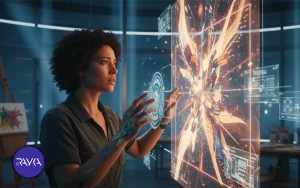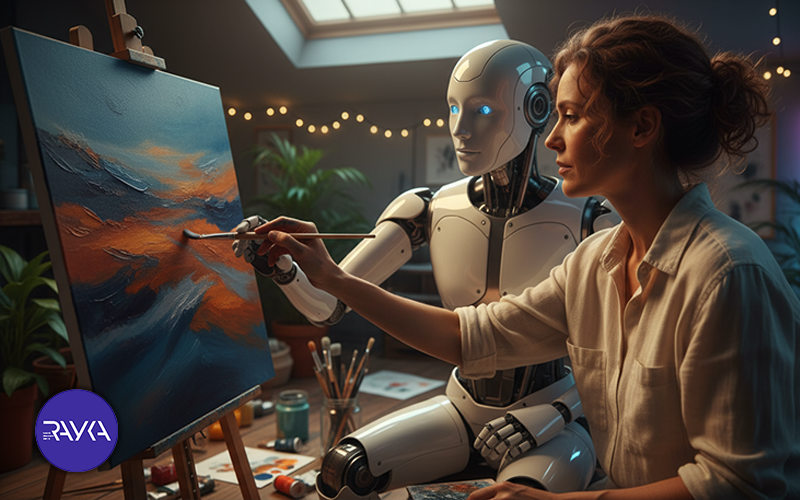
In recent years, the question “Will AI replace artists?” has become one of the hottest debates in the worlds of art and technology. Intelligent tools can now paint, compose music, and even write scripts; but does this mean human creativity is at risk?
In this article, we take a closer look at how AI has entered the creative world, what opportunities and threats it presents for artists, and whether humans might one day be pushed aside on the artistic stage.
Where human emotion merges with machine computation, a new world of creativity emerges.
Art has always been a reflection of emotion, imagination, and a perspective that only humans can possess. Through color, sound, or movement, artists show us the world from a fresh angle. But now AI has entered the arena and changed the rules of the game.
Modern technologies can learn from millions of human-created artworks and generate their own pieces in seconds; sometimes so convincingly that it becomes difficult to distinguish them from genuine human creations.
So the important question is:
Is this real creativity, or just intelligent imitation? The answer isn’t simple, but we can say this: AI can recreate creativity, but not emotion. It is still the human who gives meaning and soul to a work of art.
One of the fundamental questions is whether AI can truly create original artwork.
In recent years, AI has shown that it can not only learn from humans but also create independent artistic pieces. Software such as DALL·E, Midjourney and Stable Diffusion analyze millions of images and artistic styles, creating artworks that are sometimes nearly indistinguishable from human-made ones. Examples include:
AI can complement; or in some cases replace; artists in certain areas.
AI is no longer just a supporting tool; in many projects, it has become an essential part of the creative process. From designing cinematic environments to creating music and sound effects, its role is growing every day. But the main question remains: Where can AI replace human artists, and where is human creativity still irreplaceable?
Today, many artists use AI to speed up the creative process and reduce production costs. AI tools can imitate artistic styles, write stories, or generate visual concepts. But to create work with emotional depth and human narrative, true creativity is still required.
In some fields, AI has become a practical and effective substitute for human artists:
In films and video games, instead of performing dangerous or extremely expensive scenes in real life, creators now use AI models to produce high-risk cinematic scenes with artificial intelligence and recreate realistic environments. This approach allows production teams to generate complex sequences; such as explosions, falls, or intense chase scenes; without putting anyone at risk while significantly reducing overall costs. As a result, both the safety of actors is protected and the visual quality of the projects reaches a highly professional and reliable level.
Through face-swap technology, AI can replace an actor’s face in specific scenes; useful in reviving deceased actors, de-aging characters, or reducing the need for physical reshoots.
AI-powered animation tools can generate short promotional or educational animations in minutes without large production teams; widely used in digital marketing campaigns.

AI systems can compose background music, create sound effects, and even generate voiceovers. By learning various musical styles, these tools produce customizable and repeatable audio content ideal for ads and games.
From an economic perspective, AI means lower costs and faster production. Many brands and companies now prefer AI tools over large creative teams. However, this raises concerns about the future of artistic jobs and the long-term value of human-made art.
AI creates opportunities for increased creativity and efficiency.
Despite concerns about job replacement, AI also brings significant benefits—boosting creativity, reducing costs, and expanding access to artistic tools. Artists and content creators can use AI for inspiration, rapid execution, and even enhancing the final quality of their works.
Opportunities go beyond content creation—they also include art market analysis, user-experience design, and improving audience engagement.
Below is a summary table of AI’s major opportunities in the world of art:
| Factor | Description | Impact on Artists and Projects |
|---|---|---|
| Time and cost efficiency | Reduces the need for large teams and expensive tools | Faster production of artworks, animations, and advertisements |
| Increased creativity and inspiration | Generates fresh ideas by combining various styles and data | Creates new perspectives in design, painting, and music |
| Broader access to artistic tools | Free and simple tools available to all users | Non-experts can also enter the world of art |
| Improved quality of works | Automatic correction of light, color, sound, and movement | Enhances visual and audio appeal in artistic projects |
| Audience behavior analysis | Predicts user preferences through learning algorithms | Creates artworks tailored to the audience’s needs and emotions |
This transformation is not without risks and important questions.
While AI has created new opportunities for artistic growth, it has also raised serious ethical, emotional, and legal concerns. These challenges could change the future of art and the position of artists, especially when the line between human creativity and machine production becomes blurred. Below, we outline the key challenges and risks of this path:

The future of art may take the path of human-AI collaboration or partial replacement.
With the rapid advancement of AI, several key scenarios for the future of art are conceivable:
In fields such as fast production of advertising teasers, special effects, or repetitive music, AI can temporarily or permanently take over the role of the artist. This scenario reduces costs and speeds up production but may limit the diversity and authenticity of human-created works.
In this approach, the artist retains the creative and guiding role while AI acts as a powerful assistant or tool. The combination of human insight and machine computing power enables the creation of fresh and innovative works.
AI has not yet replaced artists and is unlikely to ever completely do so. It can play a supplementary role or even temporarily replace human effort in some areas, but creating works with emotional depth and human intent remains exclusively human. The future of art will likely be a blend of human and machine collaboration, where the artist inspires and AI serves as a smart assistant. The choices we make now will shape the path of art in the coming decades, emphasizing the importance of balancing technology and human creativity.